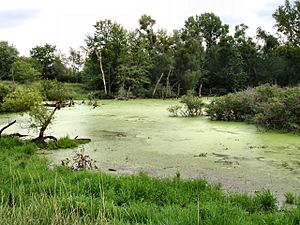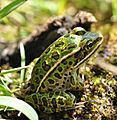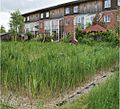Wetland facts for kids

A wetland is a special place where land and water meet. It's like a mix of a dry land and a watery area. This mix makes wetlands home to many different plants, animals, and insects. Because so many different living things can be found there, wetlands are very important for biodiversity. Many important wetlands are protected by groups like the World Wide Fund for Nature to keep them safe.
Contents
Types of Wetlands
Wetlands come in many different forms, each with its own unique features. Here are some of the main types:
Bogs and Moors
- A bog or muskeg is a type of wetland with very acidic soil made of peat. Peat is partly decayed plant material.
- A moor was originally like a bog, but this name is now often used for similar peaty areas found on hilltops.
- A moss is a term used in Scotland for a raised bog.
Fens and Carrs
- A fen is a freshwater wetland with peat, but its water is not acidic. It has a higher pH value, meaning it's more alkaline.
- A carr is a fen that has grown enough to support trees. This term is mostly used in Europe, especially in the northern UK.
Marshes
- A fresh-water marsh is an open wetland with shallow water. It mainly has low-growing plants like grasses, rushes, reeds, cattails, and sedges. The Fens in eastern England are a famous example of this type of wetland.
- A coastal (salt)-marsh has very salty water, either from the ocean or a mix of salt and fresh water. These marshes are often found near estuaries or along coastlines. Plants here, like salicornia, have special ways to live in salty conditions. Sometimes, salt-marshes are used for grazing animals or for making salt.
Swamps
- A swamp is a wetland with more open and deeper water than a marsh. In North America, swamps are usually dominated by trees and woody bushes. However, in other parts of the world, like Africa, swamps might have plants like papyrus instead of trees.
Other Wetland Types
- A dambo is a shallow, grass-covered dip in the land found in central and southern Africa. It gets waterlogged during the rainy season and often forms the start of a stream or river.
- A bayou or slough are terms used in the southern United States for a swamp with a small creek running through it. In an Indian mangrove swamp, this might be called a creek.
- A peat swamp forest is a tropical or subtropical forest wetland that produces peat. It's sometimes called a blackwater swamp.
- A constructed wetland is a wetland made by people. It's built to hold more water than the land would naturally. These human-made wetlands can help absorb flash floods, clean sewage using plants, create new homes for wildlife, or serve other human purposes.
Images for kids
-
Peat bogs are freshwater wetlands that grow where water stands and the soil isn't very fertile.
-
Bud of Nelumbo nucifera, a water plant.
-
Many types of frogs live in wetlands, or visit them to lay eggs.
-
Wetlands are a contrast to the hot, dry land around Middle Spring, Fish Springs National Wildlife Refuge, Utah.
See also
 In Spanish: Humedal para niños
In Spanish: Humedal para niños










